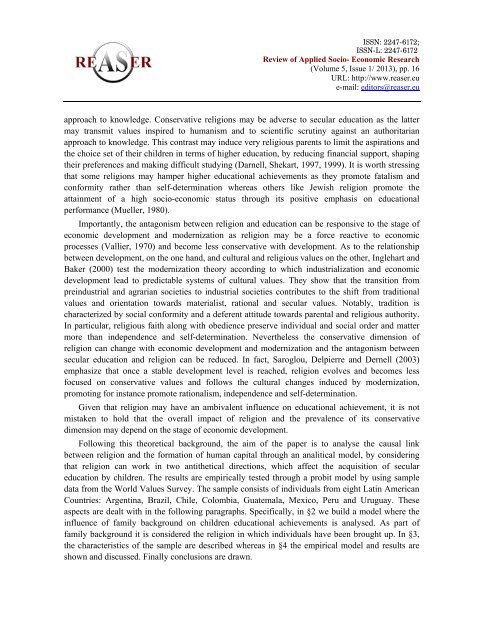new characteristics of inequalities in the information society and ...
new characteristics of inequalities in the information society and ...
new characteristics of inequalities in the information society and ...
You also want an ePaper? Increase the reach of your titles
YUMPU automatically turns print PDFs into web optimized ePapers that Google loves.
ISSN: 2247-6172;<br />
ISSN-L: 2247-6172<br />
Review <strong>of</strong> Applied Socio- Economic Research<br />
(Volume 5, Issue 1/ 2013), pp. 16<br />
URL: http://www.reaser.eu<br />
e-mail: editors@reaser.eu<br />
approach to knowledge. Conservative religions may be adverse to secular education as <strong>the</strong> latter<br />
may transmit values <strong>in</strong>spired to humanism <strong>and</strong> to scientific scrut<strong>in</strong>y aga<strong>in</strong>st an authoritarian<br />
approach to knowledge. This contrast may <strong>in</strong>duce very religious parents to limit <strong>the</strong> aspirations <strong>and</strong><br />
<strong>the</strong> choice set <strong>of</strong> <strong>the</strong>ir children <strong>in</strong> terms <strong>of</strong> higher education, by reduc<strong>in</strong>g f<strong>in</strong>ancial support, shap<strong>in</strong>g<br />
<strong>the</strong>ir preferences <strong>and</strong> mak<strong>in</strong>g difficult study<strong>in</strong>g (Darnell, Shekart, 1997, 1999). It is worth stress<strong>in</strong>g<br />
that some religions may hamper higher educational achievements as <strong>the</strong>y promote fatalism <strong>and</strong><br />
conformity ra<strong>the</strong>r than self-determ<strong>in</strong>ation whereas o<strong>the</strong>rs like Jewish religion promote <strong>the</strong><br />
atta<strong>in</strong>ment <strong>of</strong> a high socio-economic status through its positive emphasis on educational<br />
performance (Mueller, 1980).<br />
Importantly, <strong>the</strong> antagonism between religion <strong>and</strong> education can be responsive to <strong>the</strong> stage <strong>of</strong><br />
economic development <strong>and</strong> modernization as religion may be a force reactive to economic<br />
processes (Vallier, 1970) <strong>and</strong> become less conservative with development. As to <strong>the</strong> relationship<br />
between development, on <strong>the</strong> one h<strong>and</strong>, <strong>and</strong> cultural <strong>and</strong> religious values on <strong>the</strong> o<strong>the</strong>r, Inglehart <strong>and</strong><br />
Baker (2000) test <strong>the</strong> modernization <strong>the</strong>ory accord<strong>in</strong>g to which <strong>in</strong>dustrialization <strong>and</strong> economic<br />
development lead to predictable systems <strong>of</strong> cultural values. They show that <strong>the</strong> transition from<br />
pre<strong>in</strong>dustrial <strong>and</strong> agrarian societies to <strong>in</strong>dustrial societies contributes to <strong>the</strong> shift from traditional<br />
values <strong>and</strong> orientation towards materialist, rational <strong>and</strong> secular values. Notably, tradition is<br />
characterized by social conformity <strong>and</strong> a deferent attitude towards parental <strong>and</strong> religious authority.<br />
In particular, religious faith along with obedience preserve <strong>in</strong>dividual <strong>and</strong> social order <strong>and</strong> matter<br />
more than <strong>in</strong>dependence <strong>and</strong> self-determ<strong>in</strong>ation. Never<strong>the</strong>less <strong>the</strong> conservative dimension <strong>of</strong><br />
religion can change with economic development <strong>and</strong> modernization <strong>and</strong> <strong>the</strong> antagonism between<br />
secular education <strong>and</strong> religion can be reduced. In fact, Saroglou, Delpierre <strong>and</strong> Dernell (2003)<br />
emphasize that once a stable development level is reached, religion evolves <strong>and</strong> becomes less<br />
focused on conservative values <strong>and</strong> follows <strong>the</strong> cultural changes <strong>in</strong>duced by modernization,<br />
promot<strong>in</strong>g for <strong>in</strong>stance promote rationalism, <strong>in</strong>dependence <strong>and</strong> self-determ<strong>in</strong>ation.<br />
Given that religion may have an ambivalent <strong>in</strong>fluence on educational achievement, it is not<br />
mistaken to hold that <strong>the</strong> overall impact <strong>of</strong> religion <strong>and</strong> <strong>the</strong> prevalence <strong>of</strong> its conservative<br />
dimension may depend on <strong>the</strong> stage <strong>of</strong> economic development.<br />
Follow<strong>in</strong>g this <strong>the</strong>oretical background, <strong>the</strong> aim <strong>of</strong> <strong>the</strong> paper is to analyse <strong>the</strong> causal l<strong>in</strong>k<br />
between religion <strong>and</strong> <strong>the</strong> formation <strong>of</strong> human capital through an analitical model, by consider<strong>in</strong>g<br />
that religion can work <strong>in</strong> two anti<strong>the</strong>tical directions, which affect <strong>the</strong> acquisition <strong>of</strong> secular<br />
education by children. The results are empirically tested through a probit model by us<strong>in</strong>g sample<br />
data from <strong>the</strong> World Values Survey. The sample consists <strong>of</strong> <strong>in</strong>dividuals from eight Lat<strong>in</strong> American<br />
Countries: Argent<strong>in</strong>a, Brazil, Chile, Colombia, Guatemala, Mexico, Peru <strong>and</strong> Uruguay. These<br />
aspects are dealt with <strong>in</strong> <strong>the</strong> follow<strong>in</strong>g paragraphs. Specifically, <strong>in</strong> §2 we build a model where <strong>the</strong><br />
<strong>in</strong>fluence <strong>of</strong> family background on children educational achievements is analysed. As part <strong>of</strong><br />
family background it is considered <strong>the</strong> religion <strong>in</strong> which <strong>in</strong>dividuals have been brought up. In §3,<br />
<strong>the</strong> <strong>characteristics</strong> <strong>of</strong> <strong>the</strong> sample are described whereas <strong>in</strong> §4 <strong>the</strong> empirical model <strong>and</strong> results are<br />
shown <strong>and</strong> discussed. F<strong>in</strong>ally conclusions are drawn.








